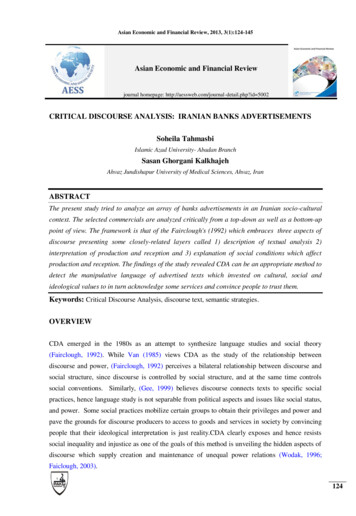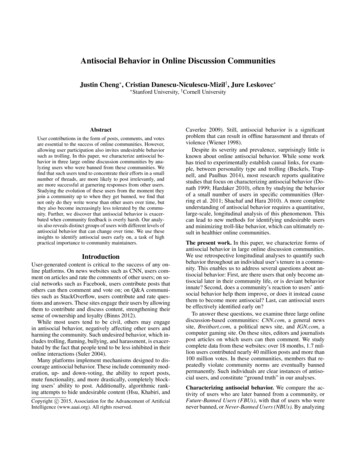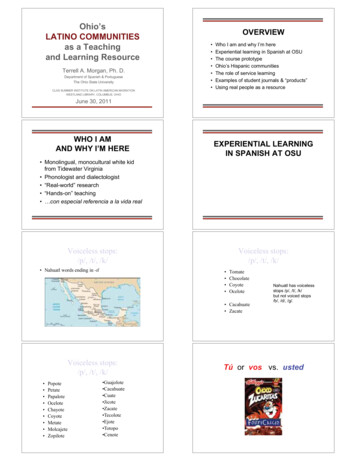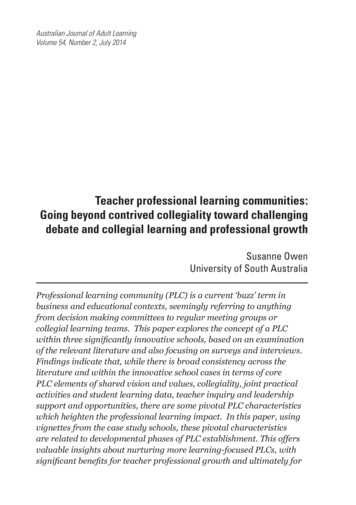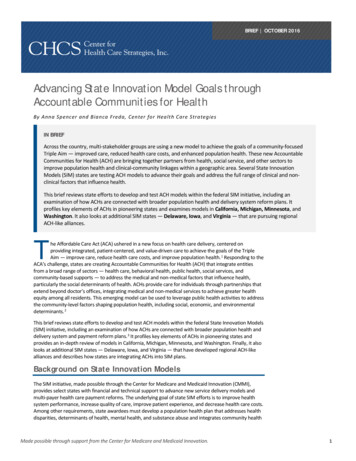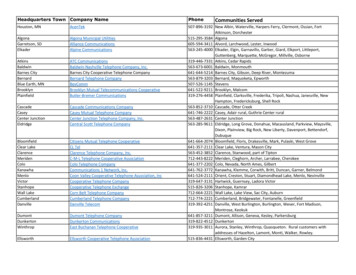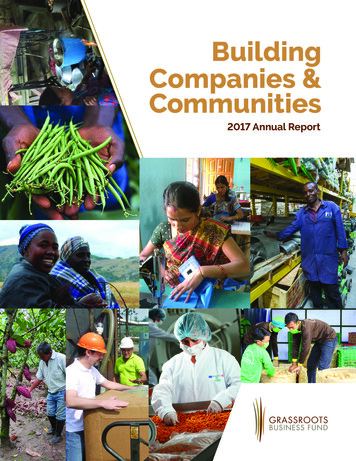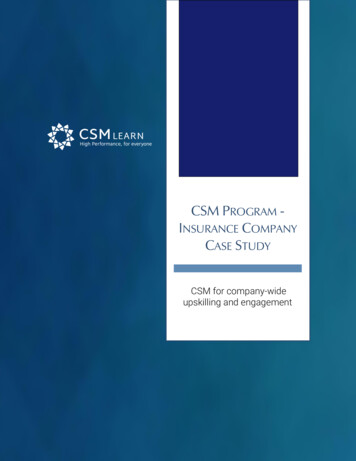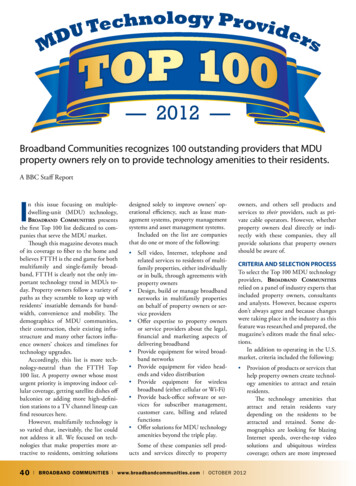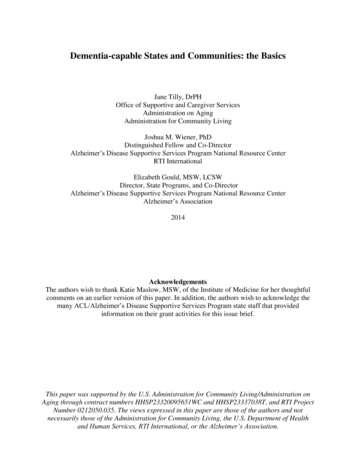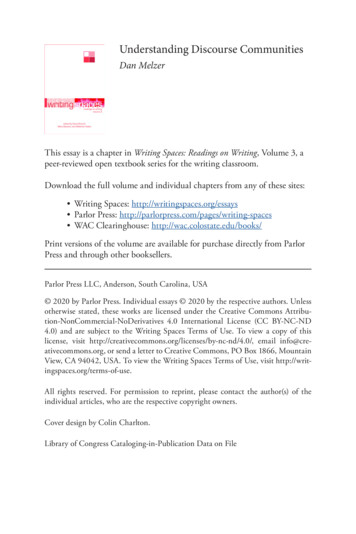
Transcription
Understanding Discourse CommunitiesDan MelzerThis essay is a chapter in Writing Spaces: Readings on Writing, Volume 3, apeer-reviewed open textbook series for the writing classroom.Download the full volume and individual chapters from any of these sites: Writing Spaces: http://writingspaces.org/essays Parlor Press: http://parlorpress.com/pages/writing-spaces WAC Clearinghouse: http://wac.colostate.edu/books/Print versions of the volume are available for purchase directly from ParlorPress and through other booksellers.Parlor Press LLC, Anderson, South Carolina, USA 2020 by Parlor Press. Individual essays 2020 by the respective authors. Unlessotherwise stated, these works are licensed under the Creative Commons Attribution-NonCommercial-NoDerivatives 4.0 International License (CC BY-NC-ND4.0) and are subject to the Writing Spaces Terms of Use. To view a copy of thislicense, visit http://creativecommons.org/licenses/by-nc-nd/4.0/, email info@creativecommons.org, or send a letter to Creative Commons, PO Box 1866, MountainView, CA 94042, USA. To view the Writing Spaces Terms of Use, visit http://writingspaces.org/terms-of-use.All rights reserved. For permission to reprint, please contact the author(s) of theindividual articles, who are the respective copyright owners.Cover design by Colin Charlton.Library of Congress Cataloging-in-Publication Data on File
7 Understanding DiscourseCommunitiesDan MelzerOverviewThis chapter uses John Swales’ definition of discourse community to explainto students why this concept is important for college writing and beyond.The chapter explains how genres operate within discourse communities,why different discourse communities have different expectations for writing, and how to understand what qualifies as a discourse community. Thearticle relates the concept of discourse community to a personal examplefrom the author (an acoustic guitar jam group) and an example of theacademic discipline of history. The article takes a critical stance regarding the concept of discourse community, discussing both the benefits andconstraints of communicating within discourse communities. The articleconcludes with writerly questions students can ask themselves as they enternew discourse communities in order to be more effective communicators.Last year, I decided that if I was ever going to achieve my lifelongfantasy of being the first college writing teacher to transform into aninternational rock star, I should probably graduate from playing thevideo game Guitar Hero to actually learning to play guitar.* I bought anacoustic guitar and started watching every beginning guitar instructionalvideo on YouTube. At first, the vocabulary the online guitar teachers usedwas like a foreign language to me—terms like major and minor chords,open G tuning, and circle of fifths. I was overwhelmed by how complicated it all was, and the fingertips on my left hand felt like they were going tofall off from pressing on the steel strings on the neck of my guitar to form* This work is licensed under the Creative Commons Attribution-NonCommercial-NoDerivatives 4.0 International License (CC BY-NC-ND 4.0) and are subject to theWriting Spaces Terms of Use. To view a copy of this license, visit http://creativecommons.org/licenses/by-nc-nd/4.0/, email info@creativecommons.org, or send a letter to CreativeCommons, PO Box 1866, Mountain View, CA 94042, USA. To view the Writing SpacesTerms of Use, visit http://writingspaces.org/terms-of-use.100
Understanding Discourse Communities101WRITING SPACES 3chords. I felt like I was making incredibly slow progress, and at the rateI was going, I wouldn’t be a guitar god until I was 87. I was also gettingtired of playing alone in my living room. I wanted to find a community ofpeople who shared my goal of learning songs and playing guitar togetherfor fun.I needed a way to find other beginning and intermediate guitar players, and I decided to try a social media website called “Meetup.com.” Itonly took a few clicks to find the right community for me—an “acousticjam” group that welcomed beginners and met once a month at a musicstore near my city of Sacramento, California. On the Meetup.com site, itsaid that everyone who showed up for the jam should bring a few songs toshare, but I wasn’t sure what kind of music they played, so I just showed upat the next meet-up with my guitar and the basic look you need to becomea guitar legend: two days of facial hair stubble, black t-shirt, ripped jeans,and a gravelly voice (luckily my throat was sore from shouting the lyrics tothe Twenty One Pilots song “Heathens” while playing guitar in my livingroom the night before).The first time I played with the group, I felt more like a junior highschool band camp dropout then the next Jimi Hendrix. I had trouble keeping up with the chord changes, and I didn’t know any scales (groups ofrelated notes in the same key that work well together) to solo on lead guitarwhen it was my turn. I had trouble figuring out the patterns for my strumming hand since no one took the time to explain them before we startedplaying a new song. The group had some beginners, but I was the leastexperienced player.It took a few more meet-ups, but pretty soon I figured out how to fitinto the group. I learned that they played all kinds of songs, from countryto blues to folk to rock music. I learned that they chose songs with simplechords so beginners like me could play along. I learned that they broughtprint copies of the chords and lyrics of songs to share, and if there were anydifficult chords in a song, they included a visual of the chord shape in thehandout of chords and lyrics. I started to learn the musician’s vocabulary Ineeded to be familiar with to function in the group, like beats per measureand octaves and the minor pentatonic scale. I learned that if I was havingtrouble figuring out the chord changes, I could watch the better guitaristsand copy what they were doing. I also got good advice from experiencedplayers, like soaking your fingers in rubbing alcohol every day for ninetyseconds to toughen them up so the steel strings wouldn’t hurt as much. Ieven realized that although I was an inexperienced player, I could contribute to the community by bringing in new songs they hadn’t played before.
WRITING SPACES 3102Dan MelzerOkay, at this point you may be saying to yourself that all of this willmake a great biographical movie someday when I become a rock icon (ormaybe not), but what does it have to do with becoming a better writer?You can write in a journal alone in your room, just like you can playguitar just for yourself alone in your room. But most writers, like mostmusicians, learn their craft from studying experts and becoming part of acommunity. And most writers, like most musicians, want to be a part ofcommunity and communicate with other people who share their goals andinterests. Writing teachers and scholars have come up with the concept of“discourse community” to describe a community of people who share thesame goals, the same methods of communicating, the same genres, and thesame lexis (specialized language).What Exactly Is a Discourse Community?John Swales, a scholar in linguistics, says that discourse communities havethe following features (which I’m paraphrasing):1. A broadly agreed upon set of common public goals2. Mechanisms of intercommunication among members3. Use of these communication mechanisms to provide informationand feedback4. One or more genres that help further the goals of the discourse community5. A specific lexis (specialized language)6. A threshold level of expert members (24-26)I’ll use my example of the monthly guitar jam group I joined to explainthese six aspects of a discourse community.A broadly Agreed Set of Common Public GoalsThe guitar jam group had shared goals that we all agreed on. In the Meetup.com description of the site, the organizer of the group emphasized thatthese monthly gatherings were for having fun, enjoying the music, andlearning new songs. “Guitar players” or “people who like music” or even“guitarists in Sacramento, California” are not discourse communities.They don’t share the same goals, and they don’t all interact with each otherto meet the same goals.
Understanding Discourse Communities103The guitar jam group communicated primarily through the Meetup.comsite. This is how we recruited new members, shared information aboutwhen and where we were playing, and communicated with each other outside of the night of the guitar jam. “People who use Meetup.com” are not adiscourse community, because even though they’re using the same methodof communication, they don’t all share the same goals and they don’t allregularly interact with each other. But a Meetup.com group like the Sacramento acoustic guitar jam focused on a specific topic with shared goalsand a community of members who frequently interact can be considered adiscourse community based on Swales’ definition.Use of These Communication Mechanismsto Provide Information and FeedbackOnce I found the guitar jam group on Meetup.com, I wanted informationabout topics like what skill levels could participate, what kind of musicthey played, and where and when they met. Once I was at my first guitar jam, the primary information I needed was the chords and lyrics ofeach song, so the handouts with chords and lyrics were a key means ofproviding critical information to community members. Communicationmechanisms in discourse communities can be emails, text messages, socialmedia tools, print texts, memes, oral presentations, and so on. One reasonthat Swales uses the term “discourse” instead of “writing” is that the term“discourse” can mean any type of communication, from talking to writingto music to images to multimedia.One or More Genres That Help Further theGoals of the Discourse CommunityOne of the most common ways discourse communities share informationand meet their goals is through genres. To help explain the concept ofgenre, I’ll use music since I’ve been talking about playing guitar and musicis probably an example you can relate to. Obviously there are many typesof music, from rap to country to reggae to heavy metal. Each of thesetypes of music is considered a genre, in part because the music has sharedfeatures, from the style of the music to the subject of the lyrics to the lexis.For example, most rap has a steady bass beat, most rappers use spokenword rather singing, and rap lyrics usually draw on a lexis associated withyoung people. But a genre is much more than a set of features. Genres ariseout of social purposes, and they’re a form of social action within discourseWRITING SPACES 3Mechanisms of Intercommunication among Members
WRITING SPACES 3104Dan Melzercommunities. The rap battles of today have historical roots in African oralcontests, and modern rap music can only be understood in the context ofhip hop culture, which includes break dancing and street art. Rap also hassocial purposes, including resisting social oppression and telling the truthabout social conditions that aren’t always reported on by news outlets. Likeall genres, rap is not just a formula but a tool for social action.The guitar jam group used two primary genres to meet the goals of thecommunity. The Meetup.com site was one important genre that was critical in the formation of the group and to help it recruit new members. Itwas also the genre that delivered information to the members about whatthe community was about and where and when the community wouldbe meeting. The other important genre to the guitar jam group were thehandouts with song chords and lyrics. I’m sharing an example of a song Ibrought to the group to show you what this genre looks like.Figure 1: Lyrics and chord changes for “Heart of Gold” by Neil Young with afingering chart for an E minor 7 chord
Understanding Discourse Communities105A Specific Lexis (Specialized Language)To anyone who wasn’t a musician, our guitar meet-ups might have sounded like we were communicating in a foreign language. We talked about theroot note of scale, a 1/4/5 chord progression, putting a capo on differentfrets, whether to play solos in a major or minor scale, double drop D tuning, and so on. If someone couldn’t quickly identify what key their songwas in or how many beats per measure the strumming pattern required,they wouldn’t be able to communicate effectively with the communitymembers. We didn’t use this language to show off or to try to discourageoutsiders from joining our group. We needed these specialized terms—thismusician’s lexis—to make sure we were all playing together effectively.A Threshold Level of Expert MembersIf everyone in the guitar jam was at my beginner level when I first joinedthe group, we wouldn’t have been very successful. I relied on more experienced players to figure out strumming patterns and chord changes,and I learned to improve my solos by watching other players use varioustechniques in their soloing. The most experienced players also helped educate everyone on the conventions of the group (the “norms” of how thegroup interacted). These conventions included everyone playing in thesame key, everyone taking turns playing solo lead guitar, and everyonebringing songs to play. But discourse community conventions aren’t alwaysjust about maintaining group harmony. In most discourse communities,new members can also expand the knowledge and genres of the community. For example, I shared songs that no one had brought before, and thatexpanded the community’s base of knowledge.WRITING SPACES 3This genre of the chord and lyrics sheet was needed to make sure everyone could play along and follow the singer. The conventions of thisgenre—the “norms”—weren’t just arbitrary rules or formulas. As with allgenres, the conventions developed because of the social action of the genre.The sheets included lyrics so that we could all sing along and make surewe knew when to change chords. The sheets included visuals
at the next meet-up with my guitar and the basic look you need to become a guitar legend: two days of facial hair stubble, black t-shirt, ripped jeans, and a gravelly voice (luckily my throat was sore from shouting the lyrics to the Twenty One Pilots song “Heathens” while playing guitar
